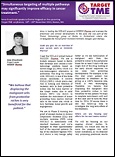Aberrant Activation of Notch Signaling in Human Breast Cancer
"Notch signaling prevents induction of the p53 target genes Puma and Noxa following mitoxantrone treatment. Western blot analysis for JNK activation, Thr81 phosphorylation of p53, Puma, Noxa, and cleaved caspase-3 levels in parental (lane 1), vector control (lane 2), MCF 10A/RBP-Jκ (lane 3), and MCF 10A/NICD (lane 4) cells treated with mitoxantrone for 16 hours. Activation of JNK and Thr81 phosphorylation of p53, leading to the up-regulation of Puma and Noxa and cleavage of caspase-3, were observed in parental and vector control cells but not in cells stably expressing RBP-Jκ/VP16 or NICD. Puma, Noxa, and cleaved caspase-3 were undetectable in untreated cells.
=====================================================
THAT'S HOW THE NOTCH ENSURE CELLS DO NOT DIE!
====================================================
Crosstalk Between Vascular Endothelial Growth Factor, Notch, and Transforming Growth Factor-β in Vascular Morphogenesis
- Matthew T. Holderfield,
- Christopher C.W. Hughes
- "
The formation of a new capillary involves endothelial cell activation, migration, alignment, proliferation, tube formation, branching, anastomosis, and maturation of intercellular junctions and the surrounding basement membrane. Each of these stages is either known or suspected to fall under the influence of the vascular endothelial growth factor, notch, and transforming growth factor-β/bone morphogenetic protein signaling pathways. Vascular endothelial growth factor is essential for initiation of angiogenic sprouting, and also regulates migration of capillary tip cells, proliferation of trunk cells, and gene expression in both." - ===========================================
- NO NEW BLOOD VESSELS WITHOUT THE NOTCH!
- SEE IMPLICATIONS FOR STROKE AND TUMOR METASTASIS========
- ========================================
- " The Jagged/Notch signaling pathways control cell fate determination and differentiation, and their dysfunction is associated with human pathologies involving cardiovascular abnormalities."(LINDNER ET AL!)
- ===================================ARRHYTHMIA AND SUDDEN DEATH IS AN AREA WHERE THE NOTCH IS IMPORTANT (OF COURSE DON'T FORGET THE DYSTROPHIES, CHANNELOPATHIES AND VARIOUS MITOCHONDRIAL DISTURBANCES (MCARDLE DISEASES)
WHERE NOTCH PLAYS, THE Wnt /cADHERIN IS NOT VERY FAR
===================================================
FOR ANY ACTIVE MOLECULE, THERE IS ONE THAT TAMPERS IT, SLOW IT DOWN...FOR THE NOTCH IT IS THE "NUMB" MOLECULE THAT "COOLS" IT!





